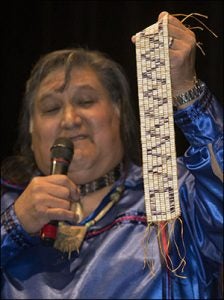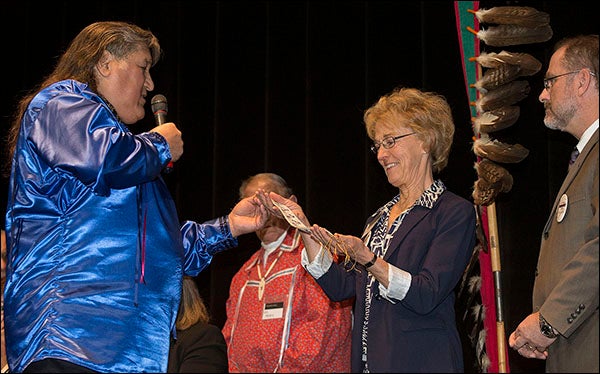‘IN HUMILITY’
Delegates of Tuscarora Nation present wampum belt to ECU
Neil Patterson Sr. of the Tuscarora Nation walked to the stage in Hendrix Theatre on East Carolina University’s campus Thursday night and announced to the audience that they were about to witness “something that hasn’t been done in a couple hundred years.”
With three chiefs, clan mothers and others representing the Tuscarora Nation on the stage with him, Patterson presented Provost Marilyn Sheerer a wampum belt for the people of the state. Wampum belts have varicolored beads arranged in patterns and used as a history record or for ceremony such as the ratification of a treaty.

Neil Patterson Sr. explains the significance of the zigzag pattern on the wampum belt before presenting it to ECU officials.
The Tuscarora delegates made the presentation during one of the first sessions of the Nooherooka 300 commemoration, which will conclude today with events near Snow Hill at the site of the 1713 battle at Fort Nooherooka.
“The last person who had this done was a guy by the name of George Washington,” Patterson said. “The Iroquois made him a belt, a large belt by the Iroquois standards. He commissioned it and they did it.”
Today, it’s hard to get the quahog shells, Patterson said. The ECU belt is seven rows wide and made of 770 beads.
“This belt is telling a story. Sometimes the wampum belt signifies a treaty or to start a treaty; sometimes they tell a story. The words are read into it,” he said.
“The wampum belt that we have today commemorates what happened 300 years ago,” he said. “This belt … will be worth its weight in gold because this hasn’t been done in 200 years.”
As he held the wampum belt up, Patterson pointed out that the design had a square at the top and a square at the bottom – both representing homeland. “And the zigzagging of the beads represents a wandering. Some people call it a migration,” he said. “A migration is what you see geese do. What happened a long time ago wasn’t a migration.”
Patterson said as he presented the belt to Sheerer, “We come in humility; we come with forgiveness in our hearts. To remember these things – what man can do to another man should never be done again.”
Sheerer held the belt as she said, “It is with a sense of honor, awe and respect for the Tuscarora Nation that I accept this wampum belt on behalf of East Carolina University and all the peoples of North Carolina.”
In her remarks, Sheerer said that the university promises to preserve and protect the wampum and will share it on campus and across the state in museums and libraries so it can be seen by other North Carolinians.
After the presentation, Daniel K. Richter of the University of Pennsylvania discussed “The Tuscarora War: Trade, Land, and Power” as the final presentation of the academic year in the Thomas Harriot College of Arts and Sciences Voyages of Discovery Lecture Series.
A scholar of Native American history prior to 1800, Richter explained the escalation of events in 1711 and 1712 leading up to the war. “Land is what is at the core of the Tuscarora War,” he said.
